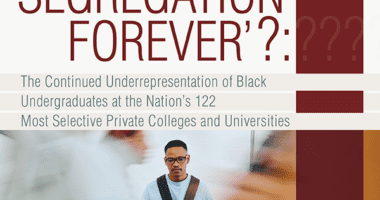Engines of Inequality: Diminishing Equity in the Nation’s Premier Public Universities
The nation’s 50 flagship universities serve disproportionately fewer low-income and minority students than in the past, according to a new report by the Education Trust. Students in the entering and graduating classes at these schools look less and less like the state populations those universities were created to serve. The study shows how financial aid choices made by these prestigious public universities result in higher barriers to college enrollment and success among low-income students and students of color.
The report, “Engines of Inequality: Diminishing Equity in the Nations Premier Public Universities,” documents in great detail how flagship and other research extensive universities contribute to serious inequities in higher education and exacerbate disturbing trends in financial aid policy at the state and federal levels. In an unprecedented study of financial aid practices at these institutions, the report illustrates how flagships have reallocated financial aid resources away from the low-income students who need help to go to college mostly to compete for high-income students that would enroll in college regardless of the amount of aid they receive.
”At a time when more and more low-income and minority students are preparing for college, it is disturbing that many of our most prestigious colleges and universities are turning away from them,” said Kati Haycock, director of the Education Trust and a co-author of the report.
”Engines of Inequality” also includes a report card for each state’s flagship institution, typically the states oldest and most prestigious public university. The report cards grade each campus on: access for low-income students; access for minority students; and gaps in graduation rates between groups. In addition, the report cards indicate whether these institutions are becoming more or less representative of their states over time.
Several universities - including West Virginia University and the University of Vermont - received high marks for providing access to minority students; others - including the University of California Berkeley and the University of Massachusetts-Amherst - received high marks for attracting low-income students. As a group however, most schools posted dismal grade point averages, and the situation is getting worse.
”Given their special role in developing their states future business, academic and political leadership, leaders of flagship universities should feel a special obligation to provide opportunities for talented state residents of all races and economic groups,” said Danette Gerald, the reports other co-author. “But over time, that obligation has been replaced by the relentless pursuit of increased selectivity and ever-higher rankings.”
Between 1995 and 2003, flagship and other research-extensive public universities actually decreased grant aid by 13 percent for students from families with an annual income of $20,000 or less, while they increased aid to students from families who make more than $100,000 by 406 percent. In 2003, these institutions spent a combined $257 million to subsidize the tuition of students from families with annual incomes over $100,000 - a staggering increase from the $50 million they spent in 1995. At the same time, poor students were disproportionately bearing the brunt of increased college tuition and fees.
These types of choices at the flagships have resulted in undergraduate populations that are less and less and reflective of the states these institutions were established to serve. For example, though minority students comprise more than 35 percent of Georgias high school graduates, they represent less than 7 percent of the entering 2004 freshmen at the University of Georgia. Even more alarming, this underrepresentation is actually getting worse at most flagship campuses. The report documents similar trends for low- and middle-income students, who are being displaced at the flagships by students from the most affluent families.
”The shifting of financial aid resources away from students who genuinely need more support shows that these schools are not merely victims of bad choices by policymakers or bad preparation in K-12. The data make it very clear that these universities are independent actors in shrinking educational opportunity in their states,” Haycock said.
Inadequate financial aid may be one reason why, at most flagship universities, students from underrepresented minority groups are also graduating at rates significantly below their white counterparts. At flagship universities as a whole, minority students graduate at only 84percent of the rate of white students a 58percent graduation rate for minorities compared to a 69percent rate for white students. Here, too, some universities, for example the University of Florida and the University of North Carolina-Chapel Hill, are doing a better job than others in making sure that students get through with a degree.
Recently, a few flagship universities have announced new efforts to expand access or success for low-income and minority students. They include Ohio State University, highlighted in the report, and the Universities of Maryland, Minnesota and Virginia, which have launched initiatives to provide more financial support to low-income students.
”These institutions should be applauded for taking the lead,” Gerald said. ”But one or two new programs won’t do the trick. They and the general public need to remain focused on the numbers and not rest until the patterns change.”
The report calls on board members and presidents at each of the nations flagship universities to review their own policies and take steps to fulfill their obligation to develop the broadest range of their states top talent. The reports recommendations include:
- Examine data on how well each of their institutions serves the states citizenry and set stretch goals;
- Focus on graduation rate gaps between different groups of students, and graduate those students that are admitted;
- Reallocate their own institutional aid dollars to provide the bulk of their tuition assistance to students who cant afford to go to college without it.
“The flagships occupy a special place in cultivating the next generation of leaders in their states. With their special status comes a special responsibility to combine excellence with equity,” Haycock said. ”The flagships need to reaffirm their historic commitment to opportunity and set a new course.”









